
Back to Blog
Technology Pete Gypps
Pete Gypps
What is MCP? Understanding Anthropic's Model Context Protocol

Published: 26 May 2025
10 min read

Written by
Pete Gypps
Technology Consultant & Digital Strategist
About This Article
Discover what the Model Context Protocol (MCP) is, how it revolutionises AI integration, and why it's becoming the standard for connecting AI assistants to external tools and data sources.
Let's Connect
Have questions about this article or need help with your IT strategy?
Book a ConsultationMore Articles

Web Development
Building a Service Business Website: Integrating with Small Business Management Tools
3rd July 2025

Technology
UK AI Strategy 2025: Government's £10 Billion Computing Capacity Investment Plan Revealed
3rd September 2025

Technology
AI Cybercrime Evolution 2025: How Criminals Use Claude & ChatGPT for Advanced Ransomware Attacks
3rd September 2025